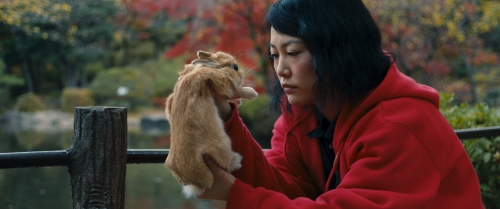Review – Kumiko the Treasure Hunter (dir. David Zellner, 2014)
by Kate
In Kumiko the Treasure Hunter (a Zellner Bros. production), a girl goes in search of a better life. Her pilgrimage takes her to from Tokyo to Fargo, North Dakota—hardly the type of place one would expect to be transformative. However, in the world of movies, the city of Fargo holds a special place. American movie buffs know this Midwestern snowscape as the setting for the darkly comedic 1994 Coen Brothers film, Fargo. It’s this movie that sets Zellner’s movie and Kumiko’s story in motion. Kumiko takes it for granted that one of the standout sequences in Fargo is real, or at least, a facsimile of a real event—the moment when Steve Buschemi’s character buries a suitcase filled with cash in a corner of North Dakota that is both desolate and unremarkable at the same time. Kumiko witnesses this action on a battered VHS tape, as a bloodied Buschemi is rippled by static. She becomes dead set on recovering the suitcase. Perhaps her confusion results from the way Fargo purposely conflates reality and fiction, or the manner in which she discovers the VHS itself, secreted away in a cave by the shore. In the end, it’s the voyage itself, not the reason, that matters.
Played by the talented Rinko Kikuchi, Kumiko is an easy heroine to empathize with. She doesn’t fit in at her job, where at 29 she’s basically over the hill. She appears lonely and sad, yet she shirks at an old acquaintance’s attempt to reconnect by literally running out the door once they have been seated in a restaurant. She speaks in a quiet monotone that underscores her desire to withdraw from a world full of people with whom she has little in common. Her only companions are her pet rabbit, Bunzo, and the carping voice of her mother, whom we never see. Faced with this bleak existence, it’s not suprising that Kumiko seeks freedom. She’s a woman on the edge—though of what, it’s hard to be sure.
Never once do we question Kumiko’s unwavering quest to uncover this treasure. In fact, we root for her the whole way. But do we worry about Kumiko? I certainly did. I worried she would regret leaving her rabbit behind; I wished she had brought a heavier jacket because I know how cold North Dakota is supposed to be; I worried Kumiko simply didn’t know what she was in for. But Kumiko doesn’t need us to worry about her. Her intuition may not be great, but she acts on her impulses in a way that is hard not admire. When thwarted on her journey, whether by bible-thumping midwesterners, benign old women, a cop who tries just a little too hard to save her, or a bus that breaks down, Kumiko is relentless in her pursuit of a treasure she is certain exists. What’s more, she has little patience for people who refuse to take her seriously.
She finds meaning and solace in something else that most viewers can identify with—movies, and the dreams they contain. Sometimes Kumiko’s world even intertwines every so slightly with the Coens’: a number of high-angle shots mimic those from Fargo. Who hasn’t tried to disappear into a movie to forget their problems? It seems like films contain the answers to all of life’s worries, if only we knew how to interpret them correctly. Kumiko is assured she has found the answer.
In a world that is frequently incorporeal, streaming, or wafting in that nebulous “cloud” we sometimes call the Internet, Kumiko’s journey is refreshingly tangible. The media landscape, too, is increasingly digital, making the tactile nature of analogue media seem often far away. VHS tapes have become an object of nostalgia. Outside of a thrift shop, it’s impossible to find technology to play these devices. Kumiko’s beloved tape is a solid object she can hold in her hands. She traces an image on the television to create a map, then makes it permanent by sewing the landmarks onto a cloth with bright-colored thread. For much of the movie she wears a blanket over her red coat, like a mythic warrior. Throughout the film, the deep red of her coat stands out across the snow in a shade that ought to be called “Kumiko red.” Her presence is hard to ignore. We see that Kumiko is someone for whom the intangible is very real.
The film is an interesting rumination on a very 21st century phenomenon. Viewers today have the ability to delve deeply into media in a way that was beyond the means of previous generations. While digital media has distanced us from the tangibility of celluloid-based cinema, it has, in a way, made movies more real and more prevalent. We can take them with us everywhere. They are documents. We can use existing films to live our own stories, as Kumiko does. We create interjections and reimaginings. Sometimes these take on lives their own.
So is the film a parable? A fever dream? A cautionary tale about the dangers of immersing yourself in fiction instead of living life to its fullest? I think Kumiko could really be any of these. As the film drew to a close, it was difficult to feel anything but absolute joy, despite the logical questions that lingered in Kumiko’s wake.
When the DVD comes out, will there be additional clues to unfurl and new evidence to peruse? Any new interpretation, loving homage, or detailed analysis of a film will always be countered by a voice of reason that warns, “Don’t look too deeply into it. It’s only a movie.”
Never listen to that voice.



